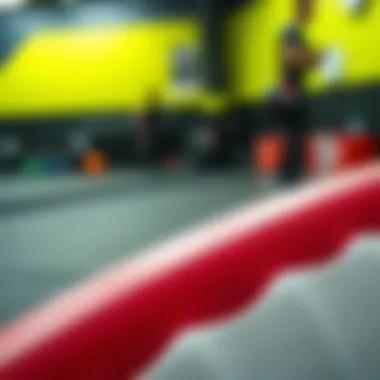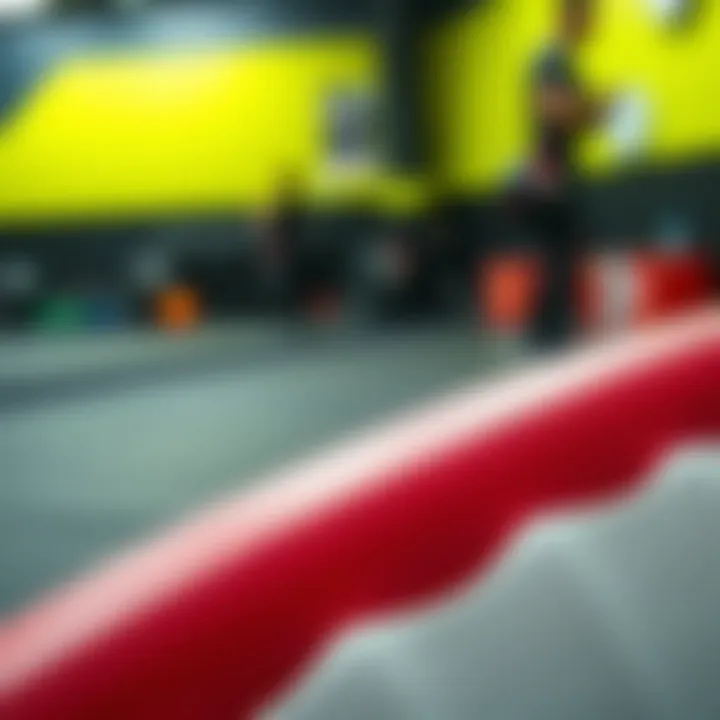Essential Weight Room Padding for Safety and Performance


Intro
In the field of fitness, safety and performance are often intertwined. One critical yet frequently overlooked element that plays a significant role in these aspects is weight room padding. The importance of proper padding cannot be overstated. It stands as a barrier, protecting individuals from the rigors of strength training while enabling them to maximize their performance. This exploration delves into the lesser-known facets of padding, shedding light on its types, installation practices, and maintenance. By understanding these elements, fitness enthusiasts, trainers, and wellness professionals can create an environment that fosters safety, thus allowing individuals to focus on their fitness journeys with confidence.
Health Benefits
Weight room padding offers several multifaceted benefits that extend beyond simple injury prevention. The mental and physical advantages must be acknowledged to fully appreciate the importance of incorporating high-quality padding into workout spaces.
Physical Health Benefits
1. Injury Prevention
Padding is essential for safeguarding against injury during workouts. When weights are dropped or equipment is bumped, padded surfaces absorb the shock, diminishing the risk of bruises, sprains, and fractures. Research indicates that over 70% of weight training injuries are linked to improper safety measures. Investing in appropriate padding can significantly reduce these occurrences.
2. Enhanced Comfort
Having well-padded areas can make a workout feel less strenuous on the body. Whether it's squatting or deadlifting, the comfort provided by quality padding contributes to better performance. Studies suggest that an increase in comfort directly correlates to prolonged endurance and improved technique during exercises.
Mental Health Benefits
1. Improved Focus
A well-constructed padded environment allows individuals to focus on their workouts without the worry of injury. This peace of mind grants them the freedom to push themselves further, fostering a positive mindset conducive to growth and resilience in fitness.
2. Increased Motivation
When individuals feel secure in their workout environment, motivation tends to flourish. The assurance that they are protected encourages them to set and achieve higher fitness goals. Consequently, they experience a greater sense of accomplishment, enhancing overall mental well-being.
"An ounce of prevention is worth a pound of cure." – Benjamin Franklin
Proper padding exemplifies this proverb within the context of weight training.
Practical Tips
Incorporating weight room padding is just the start. To maximize its benefits, fitness professionals and individuals alike must embrace practical strategies in conjunction with equipment protections.
Proper Material Selection
Choosing the right padding material makes a big difference in comfort and protection. Consider options such as foam rubber, vinyl, or polyurethane. Each serves a different purpose—foam offers cushioned support, vinyl provides durability against wear, while polyurethane combines both properties, helping create a comprehensive safety net in workout zones.
Installation Insights
Properly installing padded surfaces is crucial for maximizing their effectiveness. Consider the following tips:
- Surface Preparation: Ensure that the area is clean, level, and dry before installation to prevent air pockets.
- Secure Anchoring: Use professional-grade adhesives or screws to anchor padding securely to prevent dislocation upon heavy impact.
- Regular Checks: Inspect the padded areas periodically for signs of wear and tear. Early detection of damage can help avoid accidents down the line.
Maintenance Practices
To uphold the integrity and functionality of padding, regular maintenance is essential:
- Thorough Cleaning: Regularly clean the padded surfaces with appropriate cleaning agents to prevent the accumulation of dirt and sweat.
- Replace Worn-Out Padding: Knowing when to replace old or damaged padding can prolong safety and comfort.
For further reading on padding materials and safety standards in fitness, you may consult resources like Wikipedia and academic studies from JSTOR that delve deeper into these subjects.
Foreword to Weight Room Padding
In the ever-demanding world of fitness training, the importance of weight room padding often hides in plain sight. While many tend to focus on flashy equipment and cutting-edge techniques, the reality is that padding plays a pivotal role in both safety and performance. This article aims to navigate through the intricate world of weight room padding, shedding light on its essential elements, benefits, and the myriad details that contribute to an effective training environment.
Wearing the right shoes or using advanced weight systems is just part of the equation. Weight room padding acts as a protective barrier, reducing the risk of injury during heavy lifting or contact-based activities. Fundamental, yes, but often overlooked. As you step into the gym, you might not think about those cushioned mats or the foam wrapped around certain equipment, but they are silently working to ensure your safety and maximizing your potential while training.
Understanding the Basics of Weight Room Padding
Weight room padding can be broken down into several basic aspects, starting with its core function—protection. Padding primarily serves to absorb impact during workouts, whether from a dropped weight or a sudden fall. Consider the foam mats often found under squat racks. These aren’t just there to look good; they cushion your falls and deflect energy away from your body.
Additionally, padding comes in various forms, including foam and heavier materials like rubber, each designed with specific purposes in mind. For instance, the type of padding chosen for a free weights area may differ from what’s appropriate for a cardio zone. A basic understanding of these types can help gym owners or fitness enthusiasts make informed decisions.
The Role of Padding in Injury Prevention


Injuries in fitness settings are all too common, and one way to curb this troubling trend is by employing quality padding. Strategically placed padding can absorb shock and distribute forces more evenly, thereby reducing focal points of stress on the body. This is where ergonomics meets safety.
For instance, take a slippery weight bench. If that bench is not properly padded, a simple slip might turn into a nasty fall, potentially leading to strains or fractures. Good padding adds friction as well as cushion, creating a safer interaction surface.
"Padding is not merely an afterthought; it's a critical component in crafting a physically responsible training environment."
Among the broader benefits, the right padding can also help improve stability during lifts. It gives individuals the necessary support to push their limits without constantly worrying about slips or jolts that could lead to injury. In essence, it's about creating not just a reactive safety measure, but a proactive one. When someone feels secure, they naturally push themselves harder, which can lead to significant improvements in their fitness journey.
In summary, ignoring the role of weight room padding is like running a marathon in flip-flops—needless risk with avoidable consequences. Understanding its function, alongside the psychological comfort it brings, supports both safety and performance in any training regime.
Types of Weight Room Padding Materials
Understanding the various padding materials in weight rooms can significantly influence safety and performance. Each material comes with its own advantages and considerations which need to be evaluated depending on the specific requirements of a training environment. Choosing the right type of padding ensures that both comfort and protection are maximized, promoting a safer workout atmosphere that encourages optimal performance.
Foam Padding: Protection and Comfort
Foam padding serves as a fundamental choice for many weight rooms, largely due to its versatility and effectiveness in shock absorption. One significant benefit of foam is its ability to mold to the contours of the body, which not only enhances comfort but also minimizes the risk of injuries during high-impact activities. It acts like a cushion that softens landings, reducing the stress on joints and muscles while lifting heavy loads.
Different types of foam vary in density and thickness, which can directly correlate with their protective properties. For instance, high-density foam is often used in areas where there's a high likelihood of repetitive impacts, whereas softer foam might be suitable for general platforms and free weights areas. Additionally, because of its lightweight nature, foam padding is relatively easy to install and to replace, making it an economical option for facilities aiming for high safety standards.
"Investing in quality foam padding is like putting on a seatbelt for your workouts – crucial for safety, but often overlooked."
Vinyl vs. Rubber Padding: A Comparative Analysis
When it comes to durability and maintenance, the choice between vinyl and rubber padding is often debated among fitness professionals. Vinyl padding offers an easy-to-clean surface that resists moisture and is generally more economical. It’s essential for areas with heavy foot traffic where clean-up after sweat sessions needs to be quick and efficient. However, one downside is that it may not provide as much cushion as rubber, especially in high-impact zones.
In contrast, rubber padding typically excels in resilience, making it ideal for heavy machinery and areas requiring shock absorption. Its non-slip surface can offer enhanced safety during workouts, providing stability even in the most rigorous environments.
When choosing between these two materials, fitness trainers should consider:
- Location of the padding (e.g., floor vs. equipment)
- Frequency of use in that area
- Maintenance convenience and overall cost
Ultimately, choosing the right material hinges upon balancing durability with comfort and hygiene needs.
Specialized Padding for Different Equipment
Specialized padding plays a pivotal role in various training settings, ensuring tailored protection based on the specific equipment being utilized. For example, bench press pads are designed to offer an optimal balance between firmness and softness, allowing lifters to exert maximum effort with minimal risk. Similarly, olympic weightlifting platforms might use high-density padding that effectively absorbs the impact from dropped weights, protecting both the floor and the equipment.
In addition to standard sizes, customized padding solutions can deliver unique shapes and thicknesses to accommodate varying body types and specific movements. For instance, squat racks may benefit from padding that includes contouring for back support. Addressing the training methodology and individual athlete needs can lead to enhanced performance and reduced chances of injuries.
As such, evaluating facility-specific requirements and consulting with equipment manufacturers can foster improved training experiences that prioritize safety and effectiveness.
Key Considerations for Choosing Padding
When it comes to selecting the right weight room padding, several aspects deserve careful consideration. The primary goal here is to find padding that not only ensures safety but also enhances the overall workout experience. With many options available in the market, it's essential to understand what factors will yield the best results for fitness enthusiasts, health professionals, and trainers alike.
Evaluating Thickness and Density
Thickness and density are two critical elements affecting the protective qualities of the padding. One must balance comfort with safety. Thicker padding generally offers greater protection against impacts, which is especially important in high-intensity training environments. However, overly thick padding can compromise stability, making it challenging for users to maintain their balance and proper form during exercises.
For example, if someone is performing bench presses, a thicker layer might cushion the barbell's fall if dropped but could lead to instability while lifting. Conversely, too thin padding could expose users to injuries, failing to absorb sufficient shock during heavy lifts.
Density also plays a pivotal role in these dynamics. High-density foam is often more effective at absorbing impacts than low-density alternatives. Users should consider testing various options to find the right combination of thickness and density that fits their specific training regimen and preferences.
Ensuring Durability and Longevity
The lifespan of weight room padding is paramount. Investing in high-quality padding means you should also evaluate its durability and resistance to wear and tear. Look for materials that can withstand frequent use and substantial weight, ensuring they maintain their protective qualities over time.
For instance, commercial-grade foam and reinforced vinyl materials often stand up better against heavy lifting and the foot traffic associated with busy gym environments. Regular inspections should become part of the routine; this helps address wear issues before they lead to serious safety hazards. Over time, padding can compress and lose its effectiveness, so consider how often your facility uses specific areas and adjust your maintenance schedule accordingly.
Weight Room Aesthetics: Design and Color Choices


Aesthetics might not seem as vital in the context of safety, yet it can influence not only the mood of the gym but also client perception and motivation. The design and color choices of padding can enhance the overall vibe of a weight room. Shades that align with a gym’s branding might foster a sense of unity while creating a welcoming atmosphere.
Consider options that not only look good but also provide functionality. For example, some padding comes with customizable covers, allowing gyms to change designs easily while maintaining protective characteristics. Additionally, color can serve practical purposes, such as improved visibility, ensuring that all users are aware of designated areas or potential hazards.
A well-designed weight room not only prioritizes safety but also inspires individuals to reach their fitness goals.
In summary, conducting due diligence in evaluating thickness, density, durability, and aesthetics can dramatically affect weight room safety and performance. Prioritize these components to create a resilient and supportive environment essential for the best workout experiences.
Installation and Maintenance of Weight Room Padding
Weight room padding is one of those components that really doesn’t get enough limelight, yet its installation and upkeep can make all the difference in a training environment. Safety and performance are intimately tied to how well the padding is set up and maintained. Properly installed padding not only minimizes the risk of injury but also fosters a sense of comfort and confidence. Conversely, poorly maintained padding can lead to wear and tear that might put users at risk, ultimately affecting their workout experience. Let's break this down into two essential aspects: proper installation techniques and routine maintenance.
Proper Installation Techniques for Safety
When it comes to installing weight room padding, getting it right from the get-go is crucial. The foundation of effective padding relies not just on the material, but on how well it’s placed. Here are several key points to keep in mind:
- Surface Preparation: Ensure the surfaces where the padding will be placed are clean and dry. This prevents any moisture-related issues and ensures the adhesive, if used, bonds effectively.
- Alignment and Placement: Make sure the padding is aligned correctly, particularly around edges and corners. Misalignment can lead to gaps where injuries might occur. A level surface will help in this regard.
- Secure Fastening: If the padding is designed to be attached, secure it well using the recommended fasteners. Whether it's screws, Velcro, or adhesive, a tight fit will hold the padding in place, reducing the chance of slippage during workouts.
- Testing Stability: After installation, it's vital to test for any movement or instability. Jumping on the padding lightly or applying force can help identify any points of weakness.
"Safety in fitness begins with the right setup; don’t overlook the fundamentals of installation."
Ensuring that these techniques are followed can lead to a safer and more efficient workout atmosphere, making every inch of the space utilized to its potential.
Routine Maintenance: Cleaning and Repairing Padding
Once the padding is installed, the next step is maintaining it. Routine maintenance is more than just keeping up appearances; it’s about ensuring the longevity and safety of the equipment. Here are some tips to keep in mind:
- Regular Cleaning: Depending on the material, cleaning should be a regular part of your routine. For foam-based padding, a damp cloth and mild detergent can do wonders. If the padding is vinyl or rubber, a simple anti-microbial spray can prevent bacteria buildup.
- Inspect for Damage: Regularly inspect the padding for any signs of damage like tears, dents, or discolorization. Early detection can prevent injuries and costly replacements.
- Repair or Replace: Evaluate the damage to determine whether repairs can be made or if full replacement is necessary. If there are any rips or holes, it’s often best to repair them rather than wait until they worsen.
- Environmental Factors: Keep in mind that humidity and temperature variations can affect padding integrity. Make sure areas with padding are well-ventilated and protected from extreme conditions to prolong its life.
By actively engaging in cleaning and repairs, one promotes not only the safety of gym goers but also keeps the weight room looking fresh and professional.
The Impact of Padding on Performance
The relationship between weight room padding and athletic performance is often underestimated. Weight room padding serves not only as a protective barrier but also plays a pivotal role in enhancing an athlete's capability to perform to the best of their ability. Understanding how padding impacts performance is critical for anyone involved in fitness, from trainers to health professionals.
Enhancing Comfort During Workouts
Comfort during workouts is paramount. When training, each rep can be uncomfortable without proper cushioning, which could lead to distractions or even discourage individuals from pushing through challenging sets. Weight room padding, designed specifically for various equipment, provides a layer of comfort that encourages athletes to focus on their performance rather than discomfort or pain.
For example, consider the padded benches used in strength training. These benches reduce pressure on sensitive areas of the body, allowing an athlete to concentrate on their form and technique.
Additionally, here are some specific ways padding enhances comfort:
- Shock Absorption: High-quality padding absorbs shock, reducing impact on joints during exercises like squats or bench presses.
- Temperature Control: Certain padding materials can stay cooler, preventing overheating during intense workouts.
- Customization: Athletes can choose padding that fits personal comfort preferences, further encouraging longer and more intense training sessions.
When comfort is optimized through padding, workouts become more productive and enjoyable, which directly translates into improved performance.
Supporting Optimal Movement Mechanics
Proper movement mechanics are essential for preventing injury and maximizing performance. Weight room padding can significantly aid in achieving this optimal mechanics. With the right padding in place, athletes can execute their movements with greater precision and confidence.
Beneath this layer of comfort lies a supportive factor that enables better biomechanics during training routines. The support aids proper posture, which is critical in any weightlifting scenario. Consider squats, for instance; proper padding can assist in maintaining spinal alignment, thus helping to avert injuries.
Several critical principles underline how padding supports mechanics:
- Alignment Maintenance: Padding helps keep the body aligned during lifts, ensuring muscles engage properly.
- Feedback: With adequate padding, athletes receive tactile feedback about their body position. This feedback helps in correcting form on the fly.
- Reduced Fatigue: Adequate support reduces muscle fatigue, allowing the athlete to maintain form longer, which enhances performance.
“Investing in quality weight room padding isn't just about comfort—it's about ensuring athletes can reach their full potential safely.”
For further guidelines and a comprehensive view on the importance of equipment and safety, refer to the recommendations on safety from the Occupational Safety and Health Administration or latest fitness trends discussed on Reddit.


Industry Standards and Guidelines
When it comes to setting up a weight room, adhering to industry standards and guidelines is essential for ensuring both safety and optimal performance. These standards are not mere suggestions; they form the backbone of a healthy training environment. Understanding these regulations can help gym owners, trainers, and athletes minimize risks and enhance overall workout experiences.
Government Regulations on Fitness Equipment Safety
Government regulations regarding fitness equipment safety are designed to protect users from potential dangers associated with poorly constructed or maintained equipment. In particular, these regulations mandate certain requirements for padding materials used in fitness environments. For instance, the Consumer Product Safety Commission (CPSC) outlines strict guidelines for cushioning materials to mitigate the severity of injuries that could occur during workouts.
The key aspects of these regulations generally include:
- Material Composition: All padding used in weight rooms must meet specific chemical and safety standards to prevent skin irritation or allergic reactions.
- Impact Absorption: Regulations dictate that padding must be tested and proven effective in reducing impact forces during falls or collisions.
- Maintenance Standards: Guidelines also stipulate the need for regular inspections and maintenance of padding to ensure it remains effective and safe over time.
Before purchasing equipment or materials, it can be prudent to review CPSC guidelines to ensure compliance. By staying informed about these regulations, fitness facilities can avoid liabilities and foster a safer workout environment.
Best Practices from Fitness Associations
Fitness associations play a crucial role in advocating for safe practices within the fitness community. They frequently publish best practices tailored for gyms and fitness instructors, providing guidance on everything from equipment specifications to user safety protocols.
Some widely recognized best practices include:
- Padding Thickness and Density: Associations often recommend specific measurements for padding thickness in order to optimize shock absorption. The right density helps not just with safety but also affects comfort during workouts.
- Regular Training Workshops: Organizations like the American Council on Exercise (ACE) hold workshops where trainers can learn about the latest safety protocols and effective padding choices that enhance both performance and safety.
- User Education: Encouraging gym owners and trainers to provide clear instructions on the use of equipment can help prevent accidents. Informative signage around the gym can help remind users of best practices while exercising.
"Selecting the right padding is not just about comfort, it’s about creating a safer environment that prioritizes user well-being."
Engaging with resources from reputable fitness associations, such as National Academy of Sports Medicine (NASM) or the American College of Sports Medicine (ACSM), can also prove beneficial in staying updated on best practices.
By integrating government regulations and the guidelines from fitness associations, weight room managers can create a space that not only fosters superior performance but also ensures athletes can train with confidence.
Case Studies: Effective Weight Room Padding Solutions
The realm of fitness is not just about individual effort or even the guidance of trainers; it heavily leans on the environments where these activities occur. Notably, weight room padding plays an essential role in creating safe, efficient, and conducive training spaces. To understand its impact better, looking into real-world applications through case studies provides insight into how effective padding solutions significantly elevate workout experiences while safeguarding against injuries.
Success Stories from High-Intensity Training Environments
In facilities that focus on high-intensity training, padding is more than just a comfort; it becomes a non-negotiable aspect of safety. Take the example of a popular CrossFit gym in Atlanta, Georgia. They opted for thicker foam and rubber padding to cushion the floors beneath their plyometric stations and lifting zones. By investing in quality padding, they reported a noticeable decrease in knee and back injuries among their athletes. This proactive approach not only enhanced the user experience but also minimized downtime caused by injuries, showcasing the clear connection between proper padding and athletic performance in high-stakes environments.
Moreover, a mixed martial arts (MMA) training center took a similar route. Instead of traditional flooring, they implemented specialized shock-absorbing mats around their training rings. This not only provided an essential barrier against falls and strikes but also visibly improved their athletes' confidence during intense training sessions. The gym's owner frequently emphasizes the importance of a safe training environment, stating, "When athletes know they're cushioned from mistakes, it opens the door to pushing their limits."
These cases highlight the idea that embracing robust padding solutions in high-intensity settings can foster an atmosphere that prioritizes both safety and performance. Pension for risk is natural in such intense training, yet with the right padding, chances of injury diminish, ultimately paving the way for greater athletic accomplishments.
Innovations in Padding Technologies
Delving deeper into padding, innovations in material sciences are reshaping the landscape. Modern advancements bring forth tailored solutions that cater to the varied needs of athletes. For instance, some manufacturers have started using viscoelastic foams that respond differently based on the intensity of impact. This means that during lighter activities, the foam has a softer touch, while during high-impact movements, it hardens to offer greater protection.
A study conducted at a renowned university’s sports science lab highlighted these innovations. Researchers found that viscoelastic foam, when used in weight rooms, significantly reduced the force transmitted to the body during drops and falls. This not only cushioned athletes but also preserved their long-term joint health.
Another noteworthy technology involves mats integrated with moisture-wicking properties. These advancements aim at enhancing not only durability but also the hygiene factor - a crucial consideration for busy gyms. Such technologies save time and effort on cleaning while presenting a fresh look, pleasing both gym owners and users alike.
Epilogue
In the fast-paced world of fitness, weight room padding plays a pivotal role that shouldn't be underestimated. It is not just about comfort; it profoundly impacts safety and performance. Understanding this importance helps fitness professionals create an environment conducive to optimal training and injury prevention.
The Future of Weight Room Padding in Fitness
With advancements in technology, we can expect significant improvements in weight room padding materials. The future may see padding that is not only more effective at absorbing impact but also smarter, incorporating sensors to monitor user interaction. This evolution does not merely stop at materials. The design will likely become increasingly customizable, accommodating individual preferences and specific training modalities. Imagine padding that adapts based on user motion to provide personalized support. Health professionals, trainers, and gym owners should stay alert to these innovations, as integrating cutting-edge padding can lead to better training outcomes and enhanced safety measures.
Final Thoughts on Safety and Performance
Ultimately, the interplay of safety and performance cannot be overstated. Properly installed and maintained padding can significantly reduce the risk of injuries, particularly in high-intensity training environments. It fosters confidence among users, allowing them to push their limits while knowing that they are safeguarded. For professionals in the fitness industry, incorporating comprehensive padding solutions is no longer just a suggestion but an imperative.
By investing in quality padding and understanding its nuances, professionals can ensure that their training facilities are the epitome of safety and effectiveness. Making informed choices about padding will echo in the results of their clients, leading to a healthier and more successful community overall.
"Well-distributed padding can take a weight workout from fear to fierce, allowing athletes to focus on their performance rather than worry about their safety."
In summation, as the landscape of fitness evolves, so must our attention to foundational elements like padding. The more we grasp its significance, the better equipped we are to shape the fitness experiences of our clientele. Let's embrace the future with knowledge and intention.













